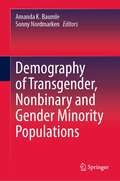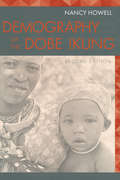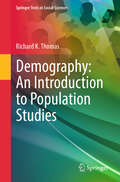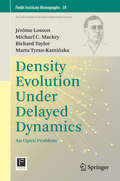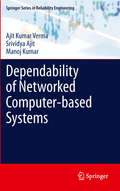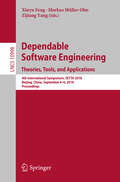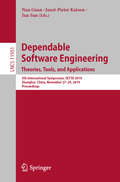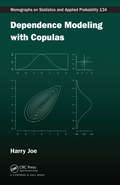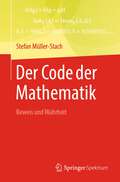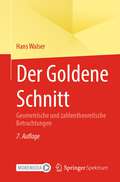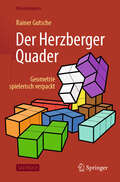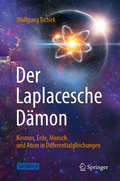- Table View
- List View
Demography of Russia
by Tatiana Karabchuk Kazuhiro Kumo Ekaterina SeleznevaThis book examines the demographic development of Russia from the late Russian Empire to the contemporary Russian Federation, and includes discussions of marriage patterns, fertility, mortality, and inter-regional migration. In this pioneering study, the authors present the first English-language overview of demographic data collection in Russia. Chapters in the book offer a systematic overview of the legislation regulating fertility and the family sphere, a study of the factors determining first and higher order births, and an examination of population distribution across Russian regions. The book also combines research tools from the social sciences with a medical approach to provide a study of mortality rates. By bringing together approaches from several disciplines - demography, economics, and sociology - the authors of this book provide a comprehensive and detailed assessment of the historical roots of Russia's demographic development.
Demography of Transgender, Nonbinary and Gender Minority Populations
by Amanda K. Baumle Sonny NordmarkenThis book provides the first compilation of demographic research focused on transgender, nonbinary, and gender minority populations. It discusses the measurement and conceptualization challenges that shape demographic knowledge of these populations, including how we capture gender on surveys. It examines our current knowledge of demographic characteristics and health disparities and outcomes. Overall, this research demonstrates the increasing knowledge of gender variation at the population level. At the same time, it reveals the need for better survey questions, additional data, and inquiry into a broader subset of demographic questions for these populations as there is little understanding of fundamental demographic information, including migration or spatial distribution of transgender populations, fertility and household structure, labor market outcomes, or broader patterns of morbidity and mortality. The research set forth in this book lays the groundwork for a trans demography that would produce population-level knowledge of these populations and points researchers and policymakers toward needed areas of research, conceptualization, and data collection.
Demography of the Dobe !Kung
by Robert GutmanFirst published in 1979, this is a classic study of the population of the Bushmen of the Kalahari Deselt of Botswana. Using methods that are simple and fully illustrated, the author presents empirical descriptions of the fertility, mortality, and marriage patterns of the now famous !Kung hunter-gatherers.The !King "Bushman" people of the Kalahari desert in Africa occupy an anomalous position in the world of science. They have been selected for intensive study precisely because they are geographically, socially, and economically removed from modern, industrialized society, living in a sparsely settled and remote portion of an enormous semidesert. The !Kung maintain the language and culture of a fully develop hunting and gathering society with (until very recently) no dependence on cultivated plants, no domesticated animals other than the dog, no stratification system based on kinship or occupation, no power or authority structure extending further than the local bands composed of a few related families, no wage labor, no use of money, and no settled sites of occupation.At the same time, the !Kung have become well-known figures to students—both undergraduate and professional—of Western social science. The faces of !Kung informants gaze from the covers and the illustrations of many texts in anthropology and sociology.Why has all this attention been developed around the !Kung people? Part of the answer lies in the people themselves. The !Kung are a physically attractive people, with slender, graceful bodies and open small-featured faces that are appealing and photogenic. Their culture is simple and has its striking features. The struggle for subsistence, the click language, the emphasis on sharing and humility, the drama of the curing dances in which individuals go into trance and speak directly to spirits to cure sickness, and the pervasive humor, teasing, and playfulness of the !Kung style are all features that are relatively easy to convey and interesting to l earn about.This work covers areas such as marriage, fertility, disease, mortality, history, and the projected future of the !Kung. This book will be of interest to students of demographic studies, anthropology, and African studies.
Demography: An Introduction to Population Studies (Springer Texts in Social Sciences)
by Richard K. ThomasThis textbook presents an overview of the field of demography from a contemporary perspective. Designed as an introductory text for undergraduates and graduates, it lays out the basic concepts, methods, and applications of the field of demography. It describes the unique characteristics of the field, reviews the basic demographic processes, and provides an overview of the analytical techniques utilized by population scientists. It emphasizes the applied nature of demography and includes a chapter on application of demography to real-world problems as well as a discussion of population policy. The text is supplemented by ample tables, graphics, and illustrations that illustrate the concepts being considered. Through including exercises as well as detailed information on the sources of demographic data, this textbook is a must have for undergraduate and graduate students in demography and population studies.
Demystifying Causal Inference: Public Policy Applications with R
by Vikram Dayal Anand MurugesanThis book provides an accessible introduction to causal inference and data analysis with R, specifically for a public policy audience. It aims to demystify these topics by presenting them through practical policy examples from a range of disciplines. It provides a hands-on approach to working with data in R using the popular tidyverse package. High quality R packages for specific causal inference techniques like ggdag, Matching, rdrobust, dosearch etc. are used in the book.The book is in two parts. The first part begins with a detailed narrative about John Snow’s heroic investigations into the cause of cholera. The chapters that follow cover basic elements of R, regression, and an introduction to causality using the potential outcomes framework and causal graphs. The second part covers specific causal inference methods, including experiments, matching, panel data, difference-in-differences, regression discontinuity design, instrumental variables and meta-analysis, with the help of empirical case studies of policy issues. The book adopts a layered approach that makes it accessible and intuitive, using helpful concepts, applications, simulation, and data graphs. Many public policy questions are inherently causal, such as the effect of a policy on a particular outcome. Hence, the book would not only be of interest to students in public policy and executive education, but also to anyone interested in analysing data for application to public policy.
Den Fehlerteufel ausgetrickst: Codierungstheorie verständlich erklärt (essentials)
by Olaf ManzDie Codierungstheorie, die sich mit Verfahren zur Erkennung und Korrektur von Fehlern bei Datenübertragungen und beim Auslesen von Speichermedien beschäftigt, ist heute aus Technik, Wirtschaft und aus unserem Alltag nicht mehr wegzudenken. Das Buch stellt anschaulich und leicht verständlich die wichtigsten, auch in der Praxis verwendeten Methoden vor. Dazu gehören Prüfziffern und CRC-Verfahren zur Fehlererkennung. Eingegangen wird aber auch auf historisch und für den heutigen Alltag wichtige Codes zur Fehlerkorrektur. Hierzu zählen insbesondere die Hamming-, Reed-Muller-, Reed-Solomon-, Faltungs- und Turbo-Codes. Verfahren, die darauf basieren, sind unter anderem beim Digitalfernsehen, beim Internet, beim Mobilfunk, in der Satellitennavigation, in der Raumfahrt, bei CDs und DVDs und bei QR-Codes implementiert.
Dense Sphere Packings: A Blueprint for Formal Proofs
by Thomas C. HalesThe 400-year-old Kepler conjecture asserts that no packing of congruent balls in three dimensions can have a density exceeding the familiar pyramid-shaped cannonball arrangement. In this book, a new proof of the conjecture is presented that makes it accessible for the first time to a broad mathematical audience. The book also presents solutions to other previously unresolved conjectures in discrete geometry, including the strong dodecahedral conjecture on the smallest surface area of a Voronoi cell in a sphere packing. This book is also currently being used as a blueprint for a large-scale formal proof project, which aims to check every logical inference of the proof of the Kepler conjecture by computer. This is an indispensable resource for those who want to be brought up to date with research on the Kepler conjecture.
Density Estimation for Statistics and Data Analysis
by Bernard. W. SilvermanAlthough there has been a surge of interest in density estimation in recent years, much of the published research has been concerned with purely technical matters with insufficient emphasis given to the technique's practical value. Furthermore, the subject has been rather inaccessible to the general statistician.The account presented in this book places emphasis on topics of methodological importance, in the hope that this will facilitate broader practical application of density estimation and also encourage research into relevant theoretical work. The book also provides an introduction to the subject for those with general interests in statistics. The important role of density estimation as a graphical technique is reflected by the inclusion of more than 50 graphs and figures throughout the text.Several contexts in which density estimation can be used are discussed, including the exploration and presentation of data, nonparametric discriminant analysis, cluster analysis, simulation and the bootstrap, bump hunting, projection pursuit, and the estimation of hazard rates and other quantities that depend on the density. This book includes general survey of methods available for density estimation. The Kernel method, both for univariate and multivariate data, is discussed in detail, with particular emphasis on ways of deciding how much to smooth and on computation aspects. Attention is also given to adaptive methods, which smooth to a greater degree in the tails of the distribution, and to methods based on the idea of penalized likelihood.
Density Evolution Under Delayed Dynamics: An Open Problem (Fields Institute Monographs #38)
by Richard Taylor Michael C. Mackey Marta Tyran-Kamińska Jérôme LossonThis monograph has arisen out of a number of attempts spanning almost five decades to understand how one might examine the evolution of densities in systems whose dynamics are described by differential delay equations. Though the authors have no definitive solution to the problem, they offer this contribution in an attempt to define the problem as they see it, and to sketch out several obvious attempts that have been suggested to solve the problem and which seem to have failed. They hope that by being available to the general mathematical community, they will inspire others to consider–and hopefully solve–the problem. Serious attempts have been made by all of the authors over the years and they have made reference to these where appropriate.
Dental Statistics Made Easy
by Nigel C. SmeetonThis essential textbook presents the basics of dental statistics in an accessible way, combining explanation in non-technical language with key messages, practical examples, suggestions for further reading and exercises complete with detailed solutions. There is an emphasis on the principles and application of statistics without the use of algebra. The statistical material is strongly rooted in practical examples drawn from a wide range of journal articles representing both dental health care delivery and clinical dentistry. The perspective is international, with papers drawn from a variety of settings around the world. Many articles are recent and report contemporary developments in dental care. The intended audience includes dental students and practitioners, those engaged in dental research and other health care professionals. For students and tutors, it covers the undergraduate curriculum, and the exercises and solutions make it ideal for course use. For practitioners and researchers it provides the first principles of study design, accessing the dental literature, and the preparation and publication of original dental research.
Deontic Logic and Legal Systems
by Pablo E. Navarro Jorge L. RodrÍguez Eugenio Bulygin Pablo E. Navarro Jorge L. RodríguezA considerable number of books and papers have analyzed normative concepts using new techniques developed by logicians; however, few have bridged the gap between the Continental (i. e. , European) and Latin American traditions in legal philosophy. This book addresses this issue by offering an introductory study on the many possibilities that logical analysis offers the study of legal systems. The volume is divided into two sections: The first covers the basic aspects of classical and deontic logic and its connections, advancing an explanation of the most important topics of the discipline by comparing different systems of deontic logic and exploring some of the most important paradoxes in its domain. The second section deals with the role of logic in the analysis of legal systems by discussing in what sense deontic logic and the logic of norm-propositions are useful tools for a proper understanding of the systematic structure of law. Arguments are provided to stress the relevance of a systematic reconstruction of law as a necessary step in the identification of the truth conditions of legal statements and the reasons for accepting or rejecting the validity of logical consequences of enacted legal norms.
Deparochialising Global Justice: Global Poverty, Human Rights Cosmopolitanism and India’s Superrich
by Aejaz Ahmad WaniThis book offers a deparochial account of global justice and addresses disenchantment stemming from its West-centricity and provincial theoretical formulations. As the recurring global poverty debate restricts the duties of alleviating poverty and inequality to the developed world, this book attempts to broaden the spectrum of duties to the superrich of the developing world. Drawing from the case study of India’s superrich as an exemplar of the potent agency of rising powers, the book examines the structural relationship between unbridled affluence and the (un)realisation of the human rights of the poor. It contends that India’s superrich, like their counterparts in other powerful developing countries, both contribute as well as benefit from the highly decentralised global economic order that (re)produces affluence of the few and deprivation of the many within these countries. In doing so, this book argues that the superrich have a positive duty to alleviate poverty and reduce inequality beyond their free-standing moral responsibility for philanthropy.
Dependability of Networked Computer-based Systems
by Manoj Kumar Srividya Ajit Ajit Kumar VermaThe measurement of dependability attributes on real systems is a very time-consuming and costly affair, making analytical or simulation modeling the only viable solutions. Dependability of Networked Computer-based Systems explores reliability, availability and safety modeling of networked computer-based systems used in life-critical applications such as avionics, nuclear power plants, automobiles and chemical process industries. Dependability of Networked Computer-based Systems gives an overview of basic dependability modeling concepts and addresses new challenges in dependability modeling of networked computer-based systems, as well as new trends, their capabilities and limitations. It covers a variety of dependability modeling methods: stochastic processes,Markov and semi-Markov models,response-time distribution,stochastic Petri-net-based modeling formalisms, andMonte Carlo simulation models.Dependability of Networked Computer-based Systems provides students and researchers with a detailed overview of dependability models and analysis techniques. Practicing engineers will also find this text a useful guide to decision-making based on system dependability at the design, operation and maintenance stages.
Dependable Software Engineering. Theories, Tools, and Applications: 4th International Symposium, Setta 2018, Beijing, China, September 4-6, 2018, Proceedings (Lecture Notes in Computer Science #10998)
by Xinyu Feng Markus Müller-Olm Zijiang YangThis book constitutes the proceedings of the Third International Symposium on Dependable Software Engineering: Theories, Tools, and Applications, SETTA 2018, held in Beijing, China, in September 2018. The 9 full papers presented together with 3 short papers were carefully reviewed and selected from 22 submissions. The purpose of SETTA is to provide an international forum for researchers and practitioners to share cutting-edge advancements and strengthen collaborations in the field of formal methods and its interoperability with software engineering for building reliable, safe, secure, and smart systems.
Dependable Software Engineering. Theories, Tools, and Applications: 5th International Symposium, SETTA 2019, Shanghai, China, November 27–29, 2019, Proceedings (Lecture Notes in Computer Science #11951)
by Nan Guan Jun Sun Joost-Pieter KatoenThis book constitutes the proceedings of the 5th International Symposium on Dependable Software Engineering: Theories, Tools, and Applications, SETTA 2019, held in Shanghai, China, in November 2019. The 8 full papers presented were carefully reviewed and selected from 26 submissions. They present cutting-edge advancements in the field of formal methods and its interoperability with software engineering and focus on the application of formal techniques and tools for building reliable, safe, secure, and smart systems with multi-dimensional complexities.
Dependence Logic
by Samson Abramsky Juha Kontinen Jouko Väänänen Heribert VollmerIn this volume, different aspects of logics for dependence and independence are discussed, including both the logical and computational aspects of dependence logic, and also applications in a number of areas, such as statistics, social choice theory, databases, and computer security. The contributing authors represent leading experts in this relatively new field, each of whom was invited to write a chapter based on talks given at seminars held at the Schloss Dagstuhl Leibniz Center for Informatics in Wadern, Germany (in February 2013 and June 2015) and an Academy Colloquium at the Royal Netherlands Academy of Arts and Sciences (March 2014). Altogether, these chapters provide the most up-to-date look at this developing and highly interdisciplinary field and will be of interest to a broad group of logicians, mathematicians, statisticians, philosophers, and scientists. Topics covered include a comprehensive survey of many propositional, modal, and first-order variants of dependence logic; new results concerning expressive power of several variants of dependence logic with different sets of logical connectives and generalized dependence atoms; connections between inclusion logic and the least-fixed point logic; an overview of dependencies in databases by addressing the relationships between implication problems for fragments of statistical conditional independencies, embedded multivalued dependencies, and propositional logic; various Markovian models used to characterize dependencies and causality among variables in multivariate systems; applications of dependence logic in social choice theory; and an introduction to the theory of secret sharing, pointing out connections to dependence and independence logic.
Dependence Modeling with Copulas (Chapman & Hall/CRC Monographs on Statistics and Applied Probability)
by Harry JoeDependence Modeling with Copulas covers the substantial advances that have taken place in the field during the last 15 years, including vine copula modeling of high-dimensional data. Vine copula models are constructed from a sequence of bivariate copulas. The book develops generalizations of vine copula models, including common and structured facto
Dependent Data in Social Sciences Research: Forms, Issues, and Methods of Analysis
by Wolfgang Wiedermann Mark Stemmler Francis L. HuangThis book covers the following subjects: growth curve modeling, directional dependence, dyadic data modeling, item response modeling (IRT), and other methods for the analysis of dependent data (e.g., approaches for modeling cross-section dependence, multidimensional scaling techniques, and mixed models). It presents contributions on handling data in which the postulate of independence in the data matrix is violated. When this postulate is violated and when the methods assuming independence are still applied, the estimated parameters are likely to be biased, and statistical decisions are very likely to be incorrect. Problems associated with dependence in data have been known for a long time, and led to the development of tailored methods for the analysis of dependent data in various areas of statistical analysis. These include, for example, methods for the analysis of longitudinal data, corrections for dependency, and corrections for degrees of freedom. Researchers and graduate students in the social and behavioral sciences, education, econometrics, and medicine will find this up-to-date overview of modern statistical approaches for dealing with problems related to dependent data particularly useful.
Deploying Secure Data Science Applications in the Cloud: From VMs to Serverless with AWS and Google Cloud
by Lucas H. BragaThis step-by-step guide is for Data Scientists, ML engineers, and DevOps practitioners who need to turn prototypes into secure, scalable production services on AWS and Google Cloud. With step-by-step instructions and practical examples, this book bridges the gap between building Data Science applications and Machine Learning models, and deploying them effectively in real-world scenarios The book begins with an introduction to essential cloud concepts, providing detailed guidance on setting up a virtual machine (VM) on AWS—and later on Google Cloud—to serve applications. This includes configuring security groups and establishing secure SSH (Secure Shell) connections using VSCode (Visual Studio Code). You will learn how to deploy a dummy HTTP Streamlit application as a foundational exercise before advancing to more complex setups. Subsequent chapters dive deeper into key deployment practices, such as configuring load balancers, setting up domain and subdomain names, and securing applications with SSL (Secure Sockets Layer) certificates. The book introduces more advanced deployment strategies using Docker containers and Nginx as a reverse proxy, as well as secure serverless deployments of Jenkins, Flask, and Streamlit. You&’ll also learn how to train machine learning models and use Flask to build APIs that serve those models in production. In addition, the book offers hands-on demonstrations for using Jenkins as an ETL platform, Streamlit as a dashboard service, and Flask for API development. For those interested in serverless architectures, it provides detailed guidance on using AWS ECS (Elastic Container Service) Fargate and Google Cloud Run to build scalable and cost-effective solutions. By the end of this book, you will possess the skills to deploy and manage data science applications on the cloud with confidence. Whether you are scaling a personal project or deploying enterprise-level solutions, this book is your go-to resource for secure and seamless cloud deployments. What You Will Learn Deploy end-to-end data science applications with a strong foundation in cloud infrastructure setup, including VM provisioning, SSH access, security groups, SSL configuration, load balancers, and domain management for secure, real-world deployments Use industry-known tools such as Docker, Nginx, Flask, Streamlit, and Jenkins to build secure, scalable services Understand how to structure and expose machine learning models via APIs for production use Explore modern serverless architectures with AWS Fargate and Google Cloud Run to scale efficiently with minimal overhead Develop a cloud deployment mindset grounded in doing things from scratch—before adopting abstracted solutions Who This Book Is For Beginning to intermediate professionals with a basic understanding of Python, including Data Scientists, ML Engineers, Data Engineers, and Data Analysts who aim to securely deploy their projects in production environments, and individuals working on both personal projects and enterprise-level solutions, leveraging AWS and Google Cloud setups
Der Code der Mathematik: Beweis und Wahrheit
by Stefan Müller-StachMotiviert durch aktuelle Entwicklungen in der abhängigen Typentheorie und bei Unendlichkategorien präsentiert dieses Buch die Ideengeschichte der Begriffe Wahrheit, Beweis, Gleichheit und Äquivalenz. Neben ausgewählten Ideen von Platon, Aristoteles, Leibniz, Kant, Frege und anderen werden Resultate von Gödel und Tarski über Unvollständigkeit, Unentscheidbarkeit und Wahrheit in deduktiven Systemen und ihren semantischen Modellen vorgestellt. Der Hauptgegenstand dieses Textes ist die abhängige Typentheorie und neuere Entwicklungen in der Homotopy Type Theory. Diese Theorien beinhalten Identitätstypen, die neue Möglichkeiten für Gleichheit, Symmetrie, Äquivalenz und Isomorphie auf konzeptuelle Weise eröffnen. Die Interaktion von Typentheorie und Unendlichkategorien ist ein neues Paradigma für eine strukturelle Sichtweise auf die Mathematik. Sie fördert auch den neuen Trend zur Formalisierung von Mathematik in Form von Beweisassistenten.
Der Garten der Unendlichkeit: Ein Projekt zur Erforschung der Unendlichkeit in der Sekundarstufe I (BestMasters)
by Stephanie KasparekStephanie Kasparek legt in diesem Buch dar, warum der abstrakte mathematische Begriff der Unendlichkeit nicht aus der Schulmathematik ausgeklammert werden soll und verbindet diese Forderung mit dem Vorschlag, erzählend Mathematik zu betreiben: Eine mathematische Reise führt die Schüler*innen zu einem geheimnisvollen Ort, dem Garten der Unendlichkeit, in dem zunächst die Protagonisten Alin und Samy - und mit ihnen die ganze Klasse - dem Zauber der Unendlichkeit nachspüren werden. Die Arbeit umfasst eine fachliche Vertiefung des mathematischen Begriffs der Unendlichkeit, die fachdidaktische Diskussion über den Nutzen einer Auseinandersetzung damit in der Sekundarstufe I sowie die Planung der Unterrichtsreihe, eine Analyse der zwei durchgeführten Erprobungen und das Unterrichtsmaterial inklusive der Erzählung.
Der Geist als komplexes Quantensystem: Interdisziplinäre Skizze einer Theory of Mind (essentials)
by Imre KoncsikImre Koncsik beschreibt die Theorie des Geistes als naturphilosophische Theorie auf Basis der Physik. Er identifiziert signifikante Parallelen zwischen Geist und Gehirn, die beide durch Elemente der Quantentheorie und der komplexen Systemtheorie beschrieben werden können. Beide Theorien beziehen sich auf eine immaterielle, formale und imaginäre Schicht der Realität. Sie ermöglichen eine innovative Beschreibung der morphologischen Strukturen und dynamischen Aktivitätsmuster des Gehirns in Analogie zu Mustern des Geistes. Eine Theorie des Geistes bildet hinsichtlich ihrer technologischen Applikation den Grundstein einer neuen, im eigentlichen Sinn ,,intelligenten" Technologie: der quantenbasierten Systemtechnologie.
Der Goldene Schnitt: Geometrische und zahlentheoretische Betrachtungen
by Hans WalserDieses Buch veranschaulicht zentrale mathematische Aspekte des Goldenen Schnittes: Es geht insbesondere auf geometrische und zahlentheoretische Zusammenhänge und Beispiele ein und macht weiterführende Betrachtungen und Verallgemeinerungen zugänglich.Das Buch richtet sich primär an Studierende, Schülerinnen und Schüler, Mathematiklehrpersonen und interessierte Laien. Es ist modular aufgebaut, so dass die einzelnen Kapitel unabhängig voneinander lesbar sind. Die Lektüre soll zu eigenen geometrischen Aktivitäten anregen. Dazu werden auch Tipps und Verfahrenshinweise aus dem handwerklich-kreativen Bereich gegeben.Ergänzende Animationen sind mit der SN More Media App abrufbar: einfach die SN More Media App kostenfrei herunterladen, ein Bild oder einen Link mit dem Play-Button scannen und sofort die Animation auf Smartphone oder Tablet ausspielen.
Der Herzberger Quader: Geometrie spielerisch verpackt
by Rainer GutscheDer Herzberger Quader ist ein räumliches Puzzle aus elf Bausteinen und wurde 1984 von Gerhard Schulze in Herzberg (Elster) vorgestellt. Sein Erfinder sah in ihm zuallererst ein geometrisches Spielzeug. Und genauso wird er im Buch präsentiert: spielerisch, mit Aufgaben, Hintergründen und detaillierten Lösungsansätzen – die Mathematik dahinter bleibt über weite Strecken fast unsichtbar. Neulinge benötigen praktisch keine mathematischen Vorkenntnisse, es werden jedoch auch Fragen aufgeworfen, die selbst Teilnehmende von gymnasialen Leistungskursen als anspruchsvoll empfinden dürften. Damit ist das Buch ebenso bestens geeignet für knobelfreudige Erwachsene, aber auch Lehrkräfte finden vielfältige Anregungen für ihren Unterricht. Im Text befinden sich zwischen ausführlichen Erklärungen immer wieder knifflige Fragestellungen, die Lesende anfangs gern überspringen dürfen. In jedem Fall bietet es sich an, während der Lektüre sowohl einen Herzberger Quader als auch Stift und Papier griffbereit zu haben. Das Buch enthält zahlreiche Aufgaben zum Zusammensetzen verschiedenster Körper und wird durch ein Kapitel über die Geschichte des Herzberger Quaders abgerundet. Die Produktfamilie WissensExpress bietet Ihnen Lehr-, Lern- und Sachbücher in kompakter Form. Die Bücher liefern schnell und verständlich fundiertes Wissen.
Der Laplacesche Dämon: Kosmos, Erde, Mensch und Atom in Differentialgleichungen
by Wolfgang TschirkDieses Buch nimmt Sie mit auf eine spannende Reise durch die Welt der Wissenschaft: von den Fallgesetzen des Galilei bis zu Einsteins Gravitationswellen, von Newtons Axiomen bis zum Wasserstoffatom, von der natürlichen Auslese bis zum Schwarmverhalten, von der Skala der Empfindungen bis zu den Grenzen des Wachstums auf unserem Planeten. Sie lernen Differentialgleichungen als mächtiges Instrument kennen, das die Mathematik zur Erforschung der Natur bereitstellt. Ihre Lösungen enthüllen, um mit Laplace zu sprechen, die Bewegungen der größten Weltkörper und des kleinsten Atoms und vieles von dem, was dazwischen liegt – einschließlich unserer selbst. Lassen Sie sich von Wolfgang Tschirk begeistern: Er gewährt Ihnen einen unterhaltsamen Blick auf die Verstandesleistungen jener, die dem Laplaceschen Dämon Stück für Stück sein Geheimnis ablauschen. Um Macht und Schönheit der Differentialgleichungen zu erleben, sollten Sie Affinität zur Mathematik mitbringen und auch vor Formeln nicht zurückschrecken. Aber Sie werden sehen: Entgegen ihrem Ruf sind Differentialgleichungen im Grunde leicht zu verstehen und oft sogar leicht zu lösen.

